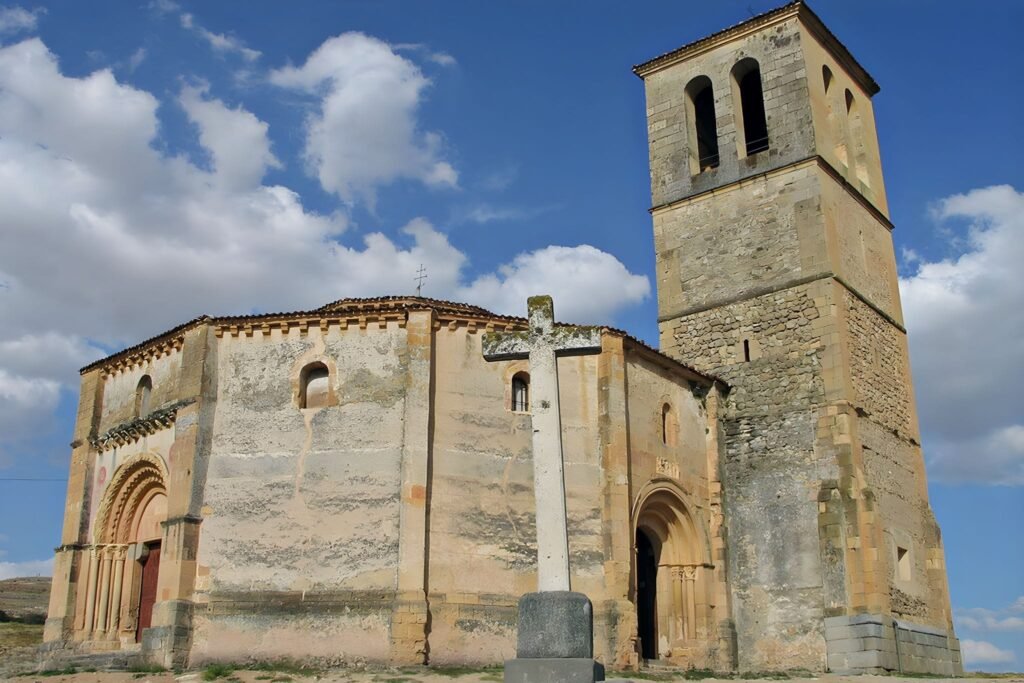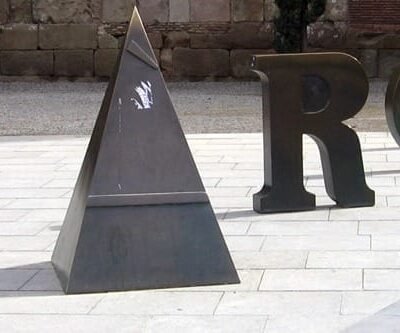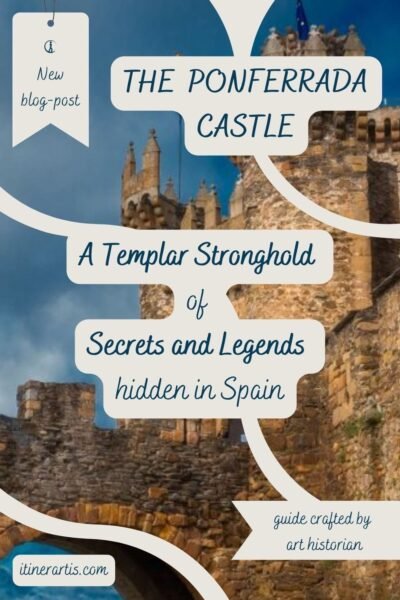Iglesia de la Vera Cruz, Segovia: The 12-Sided Mystery the Knights Templar built around the True Cross
There’s a strange hush just outside the old city walls of Segovia. The wind changes here—cooler, older—as if carrying whispers not meant for this century. Perched on a lonely rise in the San Marcos district, the Iglesia de la Vera Cruz, Segovia doesn’t announce itself. It waits. With twelve solemn sides and a silhouette both Romanesque and otherworldly, this isn’t just another Spanish church. It’s a riddle in stone.

Locals call it the Vera Cruz Church, but that name — True Cross —is only the first of many clues. Some say the Knights Templar built it. Others argue it belonged to the Order of the Holy Sepulchre from Zamora. Beneath its pyramid-topped lantern tower, inside its hollow aedicula, lies a story that refuses to settle. A story of sacred geometry, lost relics, and the lingering shadow of a splinter from the True Cross.
If you’re drawn to forgotten symbols, circular chapels, and the kind of history that hides in plain sight, you’re in the right place. This is no ordinary pilgrimage. Step quietly—Segovia holds its secrets close. And the Vera Cruz Segovia may be the strangest one of all.
Post last updated on April 3, 2025 (originally published on February 11, 2023) by Roberta Darie.

- Where to find the Iglesia de la Vera Cruz, Segovia
- A Temple of Twelve Clues: Decoding the Architecture of The Church of the True Cross
- Portals, Symbols, and Secrets
- The Central Enigma: The Aedicula Within the Vera Cruz Church, Segovia
- Of Relics and Riddles: The True Cross in Castile’s Vera Cruz Segovia
- Echoes and Shadows: Legends That Refuse to Die at Vera Cruz Segovia
- When and How to Explore the Enigmatic Iglesia de la Vera Cruz, Segovia
- Secrets Beneath Stone: The Mystery of the Iglesia de la Vera Cruz, Segovia that Refuses to Fade
“Doubt is the vestibule which all must pass before they can enter into the temple of wisdom.”
— Charles Caleb Colton

Where to find the Iglesia de la Vera Cruz, Segovia
To reach the Iglesia de la Vera Cruz, Segovia, you must step slightly off the beaten path—though not far. The church sits just outside Segovia’s medieval heart, in the quiet San Marcos district, where the stones of Castile still carry the scent of moss and myth. Follow the road toward Zamarramala, and you’ll see it: a twelve-sided silhouette standing alone on a rise, as if guarding some long-forgotten secret.
From here, the view stretches wide. Turn your head and catch the profile of the Alcázar, its towers rising like those from a fairytale—or a battlefield. Just a short walk away lies the Roman aqueduct, still defying time, and the elegant Casa de la Moneda, Spain’s royal mint turned museum. Nearby, the Monastery of San Juan de la Cruz watches in silence, another keeper of cloistered mysteries.
At 1,000 meters (3,280 feet) above sea level, Segovia’s air is thin, clear, and carries sound like a whisper. You’ll hear your own footsteps approach the Vera Cruz Church long before you touch its worn stone. The setting feels curated for contemplation, but also curiosity—exactly the kind of place a fragment of the True Cross might choose to rest. Or vanish.
Though the Romanesque style of the building is stark, almost defensive, its geometry invites wonder. Why twelve sides? Why this exact spot? And why do stories of the Knights Templar persist, despite official denials?
A Temple of Twelve Clues: Decoding the Architecture of The Church of the True Cross
Perched on a bare rise beyond Segovia’s old walls, the Iglesia de la Vera Cruz, Segovia feels strangely out of time. Austere and solemn in its pure Romanesque style, it stands barely 15 meters (50 feet) tall, yet somehow towers in mystery. Unlike most churches, it has no grand steeple, no intricate façade. Just twelve plain stone walls, each one echoing an ancient whisper. At first glance, visitors might mistake its shape for a simple octagon, but count again carefully: exactly twelve sides encircle this church, each symbolic of something deeper.
In medieval symbolism, twelve is sacred: twelve apostles, twelve houses of Israel, and twelve gates into the New Jerusalem. The designers of the Vera Cruz Church didn’t merely build—they encoded. Its dodecagonal floor plan likely drew inspiration from Jerusalem’s original Church of the Holy Sepulchre. This wasn’t architecture alone. It was faith cast into geometry, a subtle alignment between earth and heaven.
Who precisely created this sanctuary remains uncertain. Some attribute it to the famed Knights Templar, legendary guardians of holy relics and hidden knowledge. More recent historical consensus credits the Order of the Holy Sepulchre, who erected similar chapels across Castile around 1208.
Regardless, all agree it once sheltered a relic of profound significance—a fragment believed to be from the True Cross. Thus, Vera Cruz was not merely a house of worship. It was a fortress for faith, a sanctuary built to protect something rare and sacred—its story still engraved deep within the silent stones.

Portals, Symbols, and Secrets
The Iglesia de la Vera Cruz, Segovia tells its story not only through walls and geometry, but through its doors—each one a carved threshold between history and legend. The main portal is modest in scale, yet richly detailed. A semicircular arch, shaped like a horseshoe, rests upon six slender columns. At a glance, it seems simple. But look closer. These stones speak.
One capital shows David and Goliath, the boy-king triumphant beside a lion. Another reveals a trio of demons binding a sinner—grotesque, contorted, unforgettable. Vines twist into floral motifs, the language of paradise rendered in limestone. And above it all, a tympanum painted with the patriarchal cross, a red symbol once believed to guard a relic of the True Cross.
The side door, facing south, is quieter. Four columns frame two plain arches. Yet even here, there are whispers: harpies, wings outstretched; the Annunciation, barely more than a murmur. And a relief of the Three Marys at the empty tomb, a scene of silence and awe. This entrance was once sheltered by a porch, long vanished, leaving behind only questions and worn stone.
Above it all rises the tower, once a belfry, now repurposed as the Chapel of the Lignum Crucis. Its lower levels date to the 13th century, reinforced by buttresses. The upper floor—open, lighter—came later, in the 16th century. Once a stair spiraled up to the bells. Now, pilgrims ascend in search of something far older: a memory of the Vera Cruz Church as a vessel of holy fragments, of the Knights Templar, and of faith shaped not by walls, but by wonder.
![Detail of a Romanesque capital at the Iglesia de la Vera Cruz Segovia, Castile and León, Spain [Edited Photograph]. Credit: GFreihalter. Licensed under CC BY-SA 3.0.](https://itinerartis.com/wp-content/uploads/2023/02/1.-Detail-of-a-Romanesque-capital-at-the-Iglesia-de-la-Vera-Cruz-Segovia-Castile-and-Leon-Spain-Edited-Photograph.-Credit-GFreihalter.-Licensed-under-CC-BY-SA-3.0.jpg)
The Central Enigma: The Aedicula Within the Vera Cruz Church, Segovia
Step inside the Iglesia de la Vera Cruz Segovia, and you’ll find that the true mystery doesn’t rest in the walls—but in the center. Rising from the nave like a sacred heart, the aedicula is a chapel within the chapel. Dodecagonal, like the church that shelters it, this inner temple feels both intimate and immense.
Its lower floor is austere. Four ribs spring into a vault overhead, and pointed arches divide the space like the pages of an unread book. Scholars believe this floor once served for penitential rites—a place for reflection, not ceremony. But what was whispered here, and by whom, remains unrecorded.
Climb the narrow double staircase. The upper floor opens into a chamber so quiet it almost hums. Light filters through narrow slits, brushing the walls in gold. A small altar waits beneath horseshoe arches, decorated with the symbols of the Knights of Malta, later custodians of the church. Some say this room served as a vigil space, where knights would spend the night before battle in prayer and silence.
But even silence can’t hide everything. Along one wall, a wooden window opens onto two sealed chambers—small, dark, and still unexplained. Were they treasuries? Tombs? Storage for a relic of the True Cross? The official answer is unknown. And so, the question remains.
![Interior of the Church of the True Cross (Iglesia de la Vera Cruz Segovia), Castile and León, Spain [Edited Photograph]. Credit: Zangarreon. Licensed under CC BY-SA 4.0.](https://itinerartis.com/wp-content/uploads/2023/02/6.-Interior-of-the-Church-of-the-True-Cross-Iglesia-de-la-Vera-Cruz-Segovia-Castile-and-Leon-Spain-Edited-Photograph.-Credit-Zangarreon.-Licensed-under-CC-BY-SA-4.0.jpg)
Of Relics and Riddles: The True Cross in Castile’s Vera Cruz Segovia
Not far from the tower’s base lies a chamber dimly lit and thick with meaning. Known today as the Chapel of the Lignum Crucis, this modest space once held what many believed to be a sliver of the True Cross—a fragment of the very wood upon which Christ was crucified. Whether relic or relic-like, the weight of belief alone reshaped the church that housed it.
According to a papal letter sent by Honorius III in 1224, this sacred fragment was entrusted to the guardians of the Iglesia de la Vera Cruz Segovia. It’s from this relic that the church draws its name: “vera cruz”—the True Cross.
But the room was more than a reliquary. A Gothic limestone altarpiece, sculpted in 1520, towers over the small space. Beneath its carved canopy, angels hold the Instruments of the Passion—nails, hammer, crown. In its arch, a single Latin phrase is etched: “VICIT LEO DE TRIBV IVDA” — “The Lion of the Lineage of Judah has conquered.” Beneath this triumphal cry, two lions stride forward, guarding the coat of arms of Don Gonzalo de Maldonado, commander of the Vera Cruz Church in the early 16th century.
The chapel is compact—no more than a few meters across (roughly 10 feet). But the symbolism runs deep.

Echoes and Shadows: Legends That Refuse to Die at Vera Cruz Segovia
The Iglesia de la Vera Cruz Segovia is a place where history and legend blend so seamlessly that it’s hard to tell where one ends and the other begins. Officially, it was built in the year 1208 by the Order of the Holy Sepulcher, linked to their commandery in Zamora. But the popular imagination—persistent and poetic—has long tied this twelve-sided church to the Knights Templar, guardians of the True Cross and keepers of esoteric knowledge.
The Templars, after all, favored polygonal churches modeled after the Holy Sepulcher in Jerusalem. And the Vera Cruz Church, with its central aedicula and symbolic geometry, fits the pattern too well for coincidence—at least, that’s what the stories say.
One of the most enduring tales is that of the ravens. According to local legend, a knight buried near the church was once disturbed by a flock of black birds. The villagers saw it as a grave offense, a profanation of sacred rest and they cursed these animals. Since then, it is said, no raven dares approach the site. Whether myth or memory, birds still seem curiously absent from the sky above this sacred hill.
Other whispers speak of hidden relics or even buried treasure, concealed within the cryptic architecture. Some believe the church’s plan encodes celestial alignments, or conceals lost paths to Jerusalem—its twelve walls forming not just a sanctuary, but a cipher.
Today, the Knights of Malta maintain the church, holding vigil where once pilgrims pondered deeper truths. What remains is not proof, but possibility—and a silence that hums with all the things the stones cannot say aloud.
![Upper Floor of the Aedicula, Iglesia de la Vera Cruz Segovia. This mysterious altar space—possibly a chapter room or a private oratory—sits atop the central aedicula of the Vera Cruz Church. The prism-shaped altar is framed by interlacing semicircular arches forming pointed shapes, evoking unmistakable Islamic artistic influence. Of particular note are the Solomonic columns, whose spiraling shafts symbolized the ascent to the divine in medieval Christian iconography. Twisting like vines toward heaven, they echo the legendary columns of Solomon’s Temple—deepening the church’s symbolic ties to the Holy Land and its ancient wisdom. Credit: José Luis Filpo Cabana [Edited Photograph]. Licensed under CC BY 3.0.](https://itinerartis.com/wp-content/uploads/2023/02/4.-Upper-Floor-of-the-Aedicula-Vera-Cruz-Church-Segovia-Castile-and-Leon-Spain-Edited-Photograph.-Credit-Jose-Luis-Filpo-Cabana.-Licensed-under-CC-BY-3.0.jpg)
When and How to Explore the Enigmatic Iglesia de la Vera Cruz, Segovia
To reach the Iglesia de la Vera Cruz Segovia, you’ll need to step slightly beyond the old city walls—far enough to feel the quiet, close enough to walk. The church sits on a small rise in the San Marcos district, about 1.5 kilometers (0.9 miles) from Segovia’s cathedral. The walk takes 20–30 minutes and is best done slowly, letting the skyline shift behind you as the Vera Cruz Church rises ahead like a stone enigma.
Spring and autumn are the ideal seasons to visit. The light is soft, the air cool, and the crowds scarce. In early morning or late afternoon, shadows stretch across the Romanesque-style walls, and the site feels almost deserted. Perfect for those seeking silence, solitude, or simply a deeper kind of beauty.
Allow at least 1–2 hours to explore the church itself. But if you’re walking from Segovia’s old quarter, plan for half a day. Bring water, good shoes, and if you can, a notebook. This is a place that invites reflection.
For those with time, pair your visit with nearby sites: the Alcázar of Segovia, the Monastery of San Juan de la Cruz, or the charming village of Zamarramala, with sweeping views back toward the city.
If you’re lucky enough to come during Holy Week, you may witness a rare procession by the Knights of Malta, who still hold ceremonies inside the chapel. Robes, relics, and ritual bring the church’s history into motion—if only for an hour.

Secrets Beneath Stone: The Mystery of the Iglesia de la Vera Cruz, Segovia that Refuses to Fade
Where the wind bends differently outside Segovia’s walls, the Iglesia de la Vera Cruz Segovia still waits—unchanged, unread, unforgotten. Its twelve stone sides hold firm against time, but they do not explain themselves. Was it truly the Knights Templar who raised these walls? Or the Order of the Holy Sepulchre, quietly inscribing their devotion in Romanesque style? The church doesn’t answer. It simply remains.
Inside the Vera Cruz Church, questions echo louder than facts. What was sealed inside those hidden chambers? Was this a sanctuary for relics—or a monument designed to veil them? The chapel-within-a-chapel, the sacred numbers, the faded carving of the True Cross… Each is a fragment of something greater, like stars hinting at constellations we no longer remember how to read.
So, walk slowly. Let your gaze linger on the columns, on the ancient vaults. Stand still beneath the lantern tower, and feel the hush that has outlasted centuries. Here, faith was carved in geometry, and doubt was given a sacred place to rest.
And when you leave Vera Cruz, Segovia, take the mystery with you. Let it settle quietly in your chest. After all, not every riddle was meant to be solved. Some were carved in stone to keep the soul wondering.




